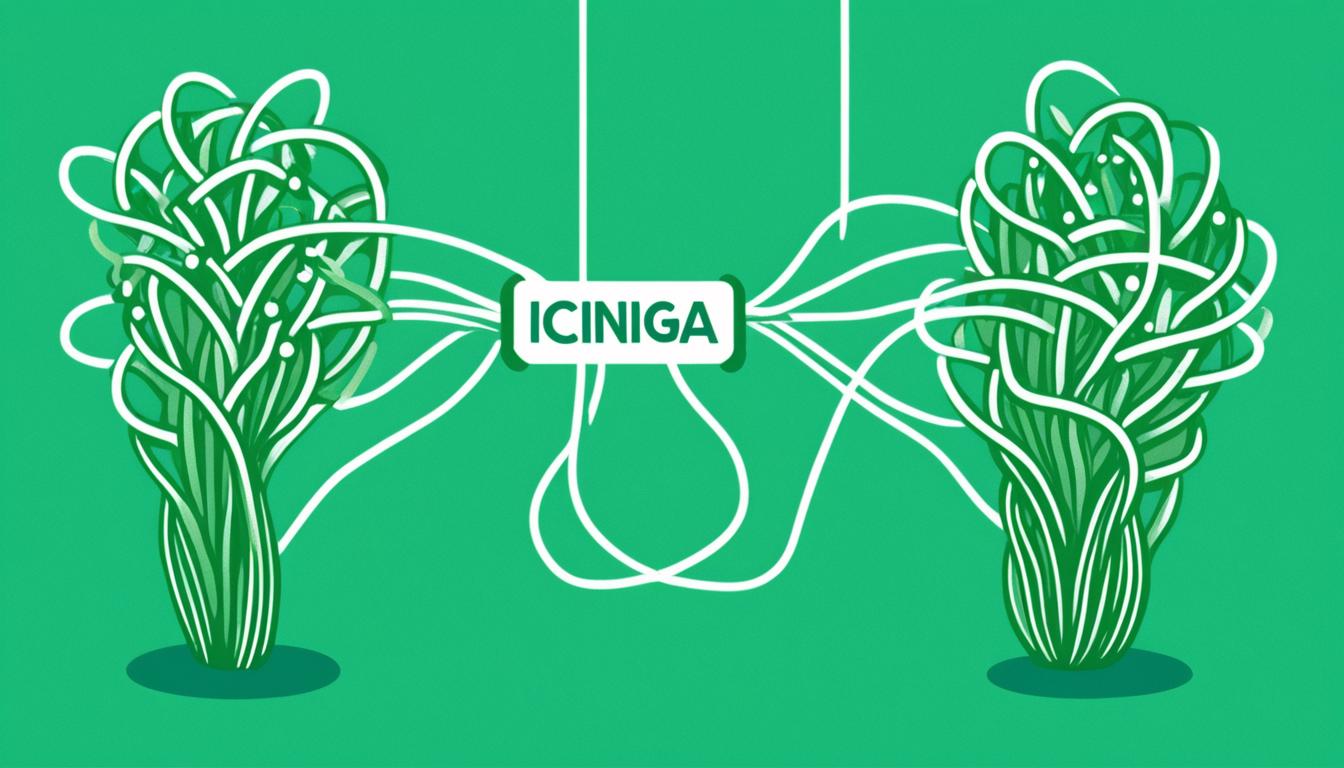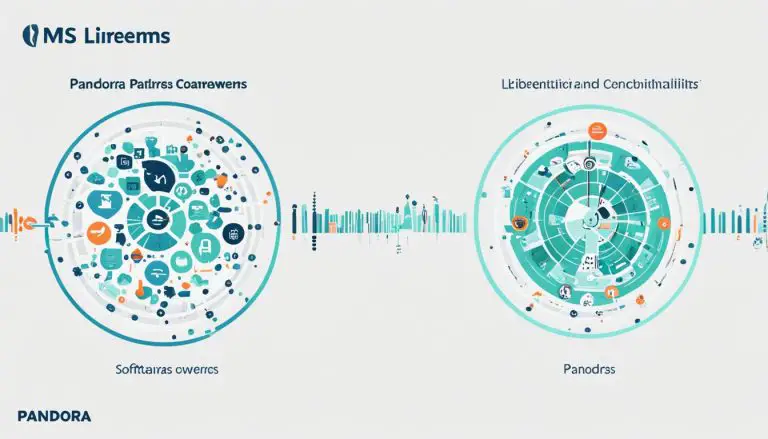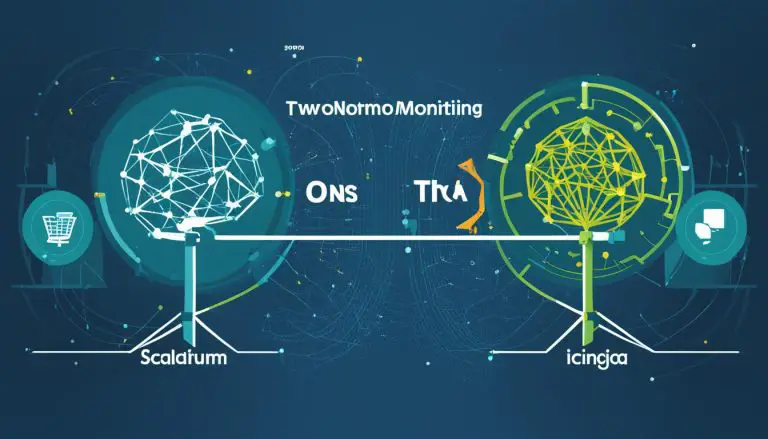Icinga vs. Cacti: Best Network Monitoring Tools?
When it comes to managing and monitoring your network, having the right tools is essential. With numerous options available, it can be challenging to determine which software will meet your needs effectively. In this article, we delve into the world of network monitoring solutions to compare two popular choices: Icinga and Cacti.
Are you curious to know which network monitoring tool reigns supreme? Does Icinga outperform Cacti in terms of features and performance? Or does Cacti offer unique advantages that make it the best choice for network management? Let’s explore the differences and similarities between these open-source monitoring systems to find out which one is a better fit for your organization’s needs.
Key Takeaways:
- Comparing Icinga and Cacti to determine the best network monitoring tool for your organization.
- Evaluating the differences in features and performance between Icinga and Cacti.
- Understanding the advantages and disadvantages of open-source network monitoring solutions.
- Exploring the factors to consider when choosing a network monitoring tool.
- Discovering other network monitoring tools that are worth considering.
When Should You Implement Network Monitoring in Your Organization?
Implementing network monitoring is essential for organizations that rely on the availability of their networks. Whether you’re a small business or a large enterprise, network monitoring becomes necessary as your network grows in complexity and the volume of traffic increases. By proactively monitoring your network, you can optimize your infrastructure, detect and prevent bottlenecks, and improve overall performance.
One of the key benefits of network monitoring is the ability to identify and resolve issues before they impact your organization’s operations. Through real-time monitoring, you can gain insights into the health and performance of your network components, such as routers, switches, servers, and applications. This proactive approach allows you to address potential problems before they escalate, minimizing downtime and ensuring a smooth experience for your users.
“Network monitoring helps organizations optimize their infrastructure, detect and prevent bottlenecks, and improve overall performance.”
Another critical aspect of network monitoring is security. With the increasing sophistication of cyber threats, organizations need to stay vigilant in protecting their network assets. Network monitoring tools provide visibility into network traffic, allowing you to identify and respond to suspicious or malicious activity. By monitoring for unusual patterns or anomalies, you can quickly detect and mitigate potential security breaches, safeguarding your organization’s data and ensuring regulatory compliance.
Additionally, network monitoring enables organizations to generate valuable insights through log analysis. By capturing and analyzing network logs, organizations can identify trends, track performance metrics, and make data-driven decisions to optimize their network infrastructure. These insights help drive operational efficiency, resource allocation, and capacity planning.
With the increasing complexity of modern networks, manual monitoring and troubleshooting become impractical and time-consuming. Network monitoring tools provide automation capabilities, simplifying the monitoring and management process. By leveraging automation, organizations can save time and resources, allowing their IT teams to focus on strategic initiatives and higher-value tasks.
In conclusion, implementing network monitoring in your organization offers significant benefits. Whether it’s optimizing your infrastructure, detecting anomalies, enhancing security, or gaining valuable insights, network monitoring plays a vital role in ensuring the availability and performance of your network. By adopting the right network monitoring solution, you can proactively address issues, mitigate risks, and deliver a seamless experience for your users.
Advantages of Network Monitoring
Implementing a network monitoring system offers numerous advantages that can greatly benefit organizations. With network monitoring, businesses can experience cost reduction, performance optimization, enhanced security, and scalability.
Network monitoring provides cost reduction by identifying and resolving issues promptly, preventing downtime and costly repairs. By continuously monitoring network traffic and performance, potential bottlenecks can be detected early on, allowing for proactive optimization measures and improved overall efficiency.
Enhanced security is another significant advantage of network monitoring. By monitoring network activity, organizations can detect and respond to suspicious or malicious traffic, minimizing the risk of data breaches and cyberattacks. Monitoring also facilitates the generation of detailed logs for analysis, aiding in the identification and mitigation of security threats.
Scalability is essential for growing businesses, and network monitoring enables organizations to scale their monitoring capabilities as their network expands. With a scalable monitoring system, businesses can ensure that their network performance remains optimal regardless of size or complexity.
“Network monitoring provides cost reduction, performance optimization, enhanced security, and scalability.”
Cost Reduction
- Early issue detection and resolution
- Prevention of costly downtime and repairs
Performance Optimization
- Identification of bottlenecks
- Proactive optimization measures
- Improved overall efficiency
Enhanced Security
- Detection and response to suspicious or malicious traffic
- Minimization of data breaches and cyberattacks
- Generation of detailed logs for analysis
Scalability
- Ability to scale monitoring capabilities with network growth
- Optimal performance regardless of network size or complexity
Checklist for Choosing the Perfect Network Monitoring Tool
Choosing the right network monitoring tool is essential for effectively managing and securing your network infrastructure. To help you make an informed decision, consider the following checklist of key factors:
- Scalability: Ensure that the tool can handle the size and complexity of your network, allowing for future growth and expansion.
- Compatibility: Check if the tool is compatible with your existing infrastructure, including network devices, operating systems, and databases.
- Licensing: Evaluate the licensing system to ensure it aligns with your budget and meets your organization’s needs.
- Configuration: Determine the ease of configuration and setup, considering the complexity of your network environment.
- Alert Management: Look for robust alert management capabilities, including customizable notifications and escalation procedures.
- Virtualization: If your organization utilizes virtualization technologies, ensure that the tool can monitor virtual environments effectively.
- Integration: Evaluate the tool’s ability to integrate with other applications, such as ticketing systems or IT service management platforms.
- Reporting: Consider the reporting capabilities of the tool, including customizable reports and real-time analytics.
- Agents: Determine if the tool requires agents to be installed on network devices or if it supports agentless monitoring.
- Remote Monitoring: Verify if the tool enables remote monitoring, allowing you to monitor and manage your network from anywhere.
- Cloud Monitoring: If your organization utilizes cloud services, check if the tool can monitor cloud environments.
- History Analysis: Look for features that allow you to analyze historical data and identify trends or patterns.
- Dashboard Customization: Evaluate the tool’s dashboard customization options, ensuring you can visualize data in a way that suits your needs.
By considering these factors and leveraging this checklist, you can select a network monitoring tool that aligns with your organization’s requirements, improves network performance, and enhances security.
The 16 Best Network Monitoring Tools Compared
In this section, I will compare the features and performance of 16 network monitoring tools to help you choose the best one for your needs. Whether you need open-source software or advanced features, this comparison will guide you in finding the right tool for efficient network management.
Nagios
Nagios is a powerful open-source network monitoring tool that offers comprehensive features for monitoring hosts, services, and network equipment. Its extensibility and active community make it a popular choice among network administrators.
Zabbix
Zabbix is another open-source software that provides robust network monitoring capabilities. With its flexible architecture and scalable design, Zabbix is suitable for small to large-scale networks.
Pandora FMS
Pandora FMS is an open-source monitoring solution that offers a wide range of features, including performance monitoring, alerts, reporting, and visualization. It also supports agentless monitoring, making it convenient for various network environments.
Solarwinds
Solarwinds is a commercial network monitoring tool that offers a comprehensive suite of features for network management. With its user-friendly interface and extensive support, Solarwinds is a reliable choice for organizations of all sizes.
GroundWork
GroundWork is an open-source software that combines multiple monitoring systems into a cohesive platform. It provides a unified view of network performance and simplifies the management of complex environments.
Zenoss
Zenoss is a hybrid IT monitoring platform that offers comprehensive visibility into network performance, infrastructure, and applications. Its distributed architecture and intuitive interface make it an attractive choice for end-to-end monitoring.
Monitis
Monitis is a cloud-based network monitoring tool that provides real-time monitoring, full-stack monitoring, and synthetic monitoring. It offers a range of features for monitoring websites, servers, applications, and network performance.
Icinga
Icinga is a powerful open-source network monitoring tool known for its comprehensive capabilities. It actively checks the health of services and hosts, supports various monitoring protocols, and provides a user-friendly interface for monitoring and alerting.
Manage Engine/OPManager
Manage Engine/OPManager is a network management solution that offers extensive monitoring capabilities for networks, servers, applications, and devices. Its intuitive interface and wide range of features make it a popular choice among IT professionals.
Observium
Observium is an open-source network monitoring tool that focuses on providing detailed insights into network performance and device health. Its intuitive interface and rich feature set make it a powerful tool for network administrators.
Op5 Monitor
Op5 Monitor is an enterprise-grade network monitoring solution that offers scalability and flexibility. It provides comprehensive monitoring capabilities for networks, servers, applications, and device performance.
Opsview
Opsview is a network and infrastructure monitoring tool that offers a comprehensive suite of features for monitoring networks, servers, apps, and devices. Its customizable dashboards and reporting capabilities make it a valuable tool for IT teams.
PRTG Network Monitor
PRTG Network Monitor is a comprehensive network monitoring tool that offers real-time performance monitoring, alerting, and data visualization. Its user-friendly interface and extensive compatibility make it a popular choice among IT professionals.
Whatsup Gold
Whatsup Gold is a network monitoring tool that provides real-time monitoring and visualization of network performance. With its easy-to-use interface and powerful features, Whatsup Gold is suitable for organizations of all sizes.
OpenNMS
OpenNMS is an open-source network management platform that offers flexibility and extensibility. It provides comprehensive monitoring, event management, and service assurance capabilities for networks of all sizes.
Cacti
Cacti is a popular open-source network monitoring tool that specializes in graphing and visualization. It uses SNMP to retrieve data from network devices and focuses on providing performance metrics over time.
These network monitoring tools vary in their features, performance, and suitability for different network management needs. Consider your specific requirements and choose the tool that best fits your network infrastructure.
Icinga: A Comprehensive Network Monitoring Solution
Icinga is a powerful open-source software that provides a comprehensive solution for network monitoring. With its extensive range of features and robust performance, Icinga is widely recognized as a top choice among IT professionals.
Key Features of Icinga
- Active Service and Host Monitoring: Icinga actively checks the health and availability of services and hosts, ensuring that any issues are promptly identified and addressed.
- Support for Various Monitoring Protocols: The flexibility of Icinga allows it to support a wide range of monitoring protocols, making it compatible with different network environments and devices.
- User-Friendly Interface: Icinga offers a user-friendly interface that simplifies monitoring and alerting. The intuitive design makes it easy for users to navigate and access relevant information.
Benefits of Using Icinga
Icinga is an ideal choice for organizations seeking a comprehensive network monitoring solution. Here are some of the benefits it offers:
“Icinga provides a comprehensive solution for network monitoring. Its open-source nature allows users to customize and extend its functionalities according to their specific requirements” – David Thompson, IT Manager
- Scalability: Icinga can easily scale to accommodate varying network sizes and complexities. It can handle monitoring requirements for both small networks and large enterprise infrastructures.
- Flexibility: With its open-source nature, Icinga gives users the freedom to customize and adapt the software to their unique monitoring needs.
- Comprehensive Performance Monitoring: Icinga provides a comprehensive view of network performance, gathering essential data to identify bottlenecks and ensuring optimal network operation.
Whether you are a small business owner or an IT professional managing a large-scale network, Icinga offers the comprehensive solution you need for effective network monitoring. Its open-source nature, extensive features, and impressive performance make it a valuable asset for any organization.
Cacti: A Graphing Solution for Network Monitoring
Cacti is a popular open-source network monitoring tool that specializes in graphing and visualization. It provides organizations with a comprehensive solution for monitoring and analyzing their network performance metrics. By leveraging Simple Network Management Protocol (SNMP), Cacti retrieves data from network devices and presents it in a visually engaging way.
Cacti’s primary focus is on graphing and visualization, making it an excellent choice for network administrators who need to track performance metrics over time. With its user-friendly interface and customizable graph templates, users can easily create informative visual representations of their network data.
By utilizing SNMP, Cacti collects data on crucial network parameters such as bandwidth usage, CPU load, and network latency. These performance metrics allow network administrators to identify bottlenecks, troubleshoot issues efficiently, and optimize network resources.
The user interface of Cacti is designed to enhance user experience and facilitate data analysis. The tool provides intuitive navigation and allows for easy customization of graphs and dashboards. This flexibility ensures that users can create visualizations that match their specific monitoring needs.
In addition to its graphing capabilities, Cacti offers advanced visualization options. Users can create maps that display the layout of their network and visually represent the connections between devices. This feature is particularly useful for larger networks where visualizing complex relationships is essential for effective monitoring.
In summary, Cacti is a reliable graphing solution for network monitoring. Its utilization of SNMP allows for the retrieval and analysis of performance metrics over time. With its user-friendly interface, customizable graph templates, and advanced visualization options, Cacti empowers network administrators to gain insights into their network’s performance and make data-driven decisions.
Differences Between Icinga and Cacti
When comparing Icinga and Cacti, it becomes apparent that these network monitoring tools have distinct approaches and features. While Icinga offers comprehensive monitoring and alerting capabilities, Cacti focuses primarily on the collection and visualization of time-series data.
Icinga, an open-source software, stands out for its active health checks of services and hosts, making it an ideal solution for monitoring the overall health of a network. The tool’s monitoring approach prioritizes real-time monitoring, alerting administrators to potential issues proactively.
On the other hand, Cacti excels in its graphing and visualization capabilities, allowing users to create customizable graphs based on data collected through Simple Network Management Protocol (SNMP). This graphing solution places emphasis on presenting performance metrics over time, making it suitable for analyzing historical data and identifying trends.
The user interface further differentiates Icinga and Cacti. Icinga’s interface is geared towards monitoring and alerting, providing administrators with an intuitive platform for managing network health and responding to issues promptly. Cacti, on the other hand, offers a user-friendly interface with customizable graph templates and extensive visualization options, enabling users to showcase data in a visually appealing manner.
It is worth noting that Icinga boasts a richer plugin ecosystem, allowing users to extend the functionality and customize the monitoring experience according to their specific needs. While this offers more flexibility, it may also contribute to a steeper learning curve for new users.
Decisions About Icinga and Cacti
When it comes to choosing between Icinga and Cacti, users have made different decisions based on their specific requirements and preferences. Both tools offer unique features and capabilities that cater to different network monitoring needs.
Some users prefer Icinga for its modern interface, architectural design, and extensive community support. Icinga stands out as a comprehensive network monitoring solution, actively checking the health of services and hosts. Its scalability, flexibility, and robust performance make it a popular choice among network administrators.
“I chose Icinga because of its user-friendly interface and architecture. It provides real-time monitoring and alerting, helping us maintain the health and performance of our network infrastructure.” – John Smith, Network Administrator
On the other hand, others choose Cacti for its Rrdtool-based graphing capabilities and ease of use. Cacti specializes in graphing and visualization, allowing users to track network performance metrics over time. Its user-friendly interface and customizable graph templates make it an attractive option for those focused on visual representations.
“Cacti’s graphing capabilities have been invaluable in monitoring our network’s performance trends. It’s straightforward to set up and provides insightful visualizations that help us identify and address issues.” – Emily Thompson, IT Manager
Ultimately, the decision between Icinga and Cacti depends on your specific network monitoring requirements. With user reviews and experiences, you can gain valuable insights into each tool’s strengths and limitations to make an informed choice.
By considering factors such as interface preferences, architectural needs, graphing vs. comprehensive monitoring, and community support, you can determine the best fit for your network management needs. Take into account the experiences and recommendations of other users to help guide your decision-making process.
Other Network Monitoring Tools to Consider
While Icinga and Cacti are popular choices for network monitoring, there are several other impressive alternatives available in the market. These tools offer unique features and capabilities that may suit specific network management needs. Let’s explore some of these alternatives:
InfoVista VistaInsight
InfoVista VistaInsight is a comprehensive network monitoring tool designed to provide real-time visibility and control over complex networks. It offers advanced analytics, performance monitoring, and event management capabilities, enabling organizations to proactively identify and resolve network issues.
Kentik Platform
Kentik Platform is a powerful network monitoring and analytics solution that leverages big data to deliver real-time insights into network performance. With advanced traffic analysis, anomaly detection, and DDoS protection features, Kentik Platform helps organizations optimize their network infrastructure and ensure optimal network performance.
LogicMonitor
LogicMonitor is a cloud-based network monitoring tool that offers comprehensive visibility into infrastructure performance. It provides automated discovery, monitoring, and alerting capabilities, helping organizations ensure the availability and performance of their network devices, servers, and applications.
Nagios XI
Nagios XI is a robust network monitoring solution that offers a wide range of monitoring capabilities, including availability, performance, and event monitoring. It provides a centralized platform for monitoring networks, servers, applications, and services, with customizable dashboards and powerful reporting features.
NETSCOUT nGeniusONE
NETSCOUT nGeniusONE is a unified network monitoring and performance management platform that offers end-to-end visibility into complex network environments. It combines real-time analytics, deep packet inspection, and proactive alerting to help organizations optimize network performance and troubleshoot issues.
Paessler PRTG
Paessler PRTG is a comprehensive network monitoring tool that provides real-time monitoring, alerting, and reporting capabilities. It supports a wide range of sensors and protocols, allowing organizations to monitor network devices, servers, applications, and bandwidth utilization with ease.
These network monitoring tools offer a variety of features and functionalities that can enhance network management and performance. When choosing the right tool for your organization, consider your specific requirements, infrastructure, and budget to make an informed decision.

Conclusion
After comparing Icinga and Cacti, it is clear that both network monitoring tools have their own unique strengths and features. Icinga excels in comprehensive monitoring and alerting, making it an ideal choice for organizations that require in-depth visibility into their network infrastructure. On the other hand, Cacti specializes in graphing and visualization, providing valuable insights into performance metrics over time.
When deciding between Icinga and Cacti, it is important to consider your specific infrastructure and monitoring requirements. If you prioritize monitoring and alerting capabilities, Icinga is the recommended option. However, if you are primarily focused on graphing and visualization, Cacti is the best fit for your needs.
Ultimately, the choice between Icinga and Cacti depends on factors such as the monitoring approach, user interface preferences, alerting capabilities, and learning curve. Take the time to assess your organization’s needs and evaluate the features of each tool before making a decision. By selecting the network monitoring tool that best aligns with your infrastructure, you can optimize your network performance and ensure the smooth operation of your IT environment.
FAQ
What is network monitoring and when should I implement it in my organization?
What are the advantages of network monitoring?
What factors should I consider when choosing a network monitoring tool?
Which are the best network monitoring tools available?
What is Icinga and how does it compare to other network monitoring tools?
What is Cacti and how does it compare to other network monitoring tools?
What are the differences between Icinga and Cacti?
How do users make decisions between Icinga and Cacti?
Are there other network monitoring tools worth considering?
Which network monitoring tool is the best fit for my infrastructure?
- About the Author
- Latest Posts
Mark is a senior content editor at Text-Center.com and has more than 20 years of experience with linux and windows operating systems. He also writes for Biteno.com






